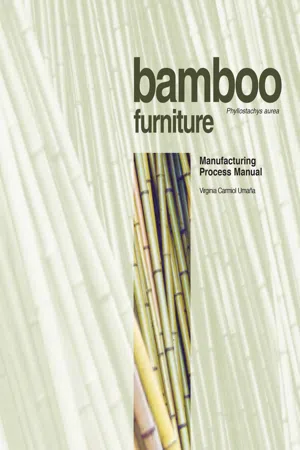
This is a test
- 172 pages
- English
- ePUB (mobile friendly)
- Available on iOS & Android
eBook - ePub
Bamboo furniture. Phyllostachys aurea
Book details
Book preview
Table of contents
Citations
About This Book
Phyllostachys aurea is a manual the pretends to bring out the many possibilities that bamboo offers. The work describes the different varieties and species of this plant, and in plain language and with illustrations, describes techniques for the manufacture of craft products, as well as a synthesis on design and ergonomic factors specific to furniture.
Frequently asked questions
At the moment all of our mobile-responsive ePub books are available to download via the app. Most of our PDFs are also available to download and we're working on making the final remaining ones downloadable now. Learn more here.
Both plans give you full access to the library and all of Perlego’s features. The only differences are the price and subscription period: With the annual plan you’ll save around 30% compared to 12 months on the monthly plan.
We are an online textbook subscription service, where you can get access to an entire online library for less than the price of a single book per month. With over 1 million books across 1000+ topics, we’ve got you covered! Learn more here.
Look out for the read-aloud symbol on your next book to see if you can listen to it. The read-aloud tool reads text aloud for you, highlighting the text as it is being read. You can pause it, speed it up and slow it down. Learn more here.
Yes, you can access Bamboo furniture. Phyllostachys aurea by Virginia Carmiol Umaña in PDF and/or ePUB format, as well as other popular books in Design & Design Allgemein. We have over one million books available in our catalogue for you to explore.
Information
Topic
DesignSubtopic
Design Allgemein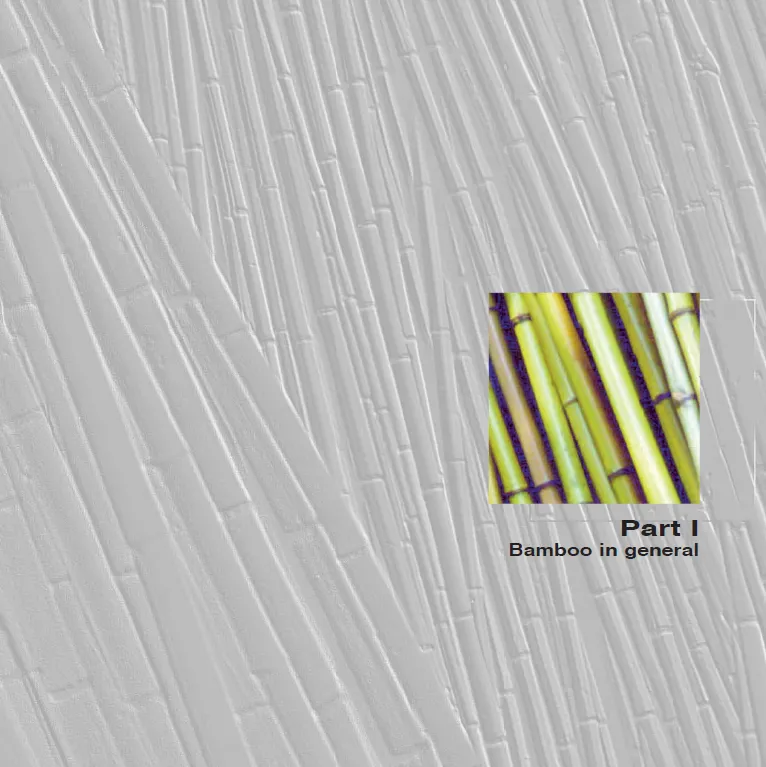
Introduction
The history of bamboo goes back to the Cretaceous Period. Since prehistoric times, this plant has been associated with part of the daily life of humans.
At the present time, 80% of bamboo cultivation is found in tropical Southeast Asia, an area of approximately fourteen million hectares. [Some thirty eight million, plus, acres.]
In most Asian countries, bamboo is synonymous with wealth. However, in our country, it is not valued as a useable natural resource; not only its cultivation is not encouraged, but, sadly, it is thoughtlessly destroyed.
It is the purpose of this work to broaden the perspective of the average citizen by offering a new and positive image of bamboo and demonstrating its diverse uses in construction, architecture, engineering, medicine, and paper manufacturing. According to experience in other countries, it has been shown that the yield per hectare of bamboo is very high, higher even than that for coffee.
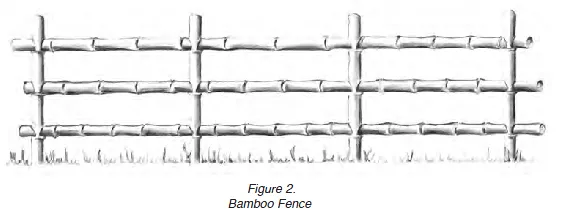
The advantages of bamboo derives from the fact that it requires practically no investment or maintenance in comparison with the wide range of uses to which it may be put. The industrialization of bamboo requires no complex methods, but can be worked very simply with purely craft techniques. This presents an unprecedented opportunity in the employment of unemployed labor; nor does it require prior preparation. It is indeed the plant that can assist agricultural communities to subsist and develop. The uses to which bamboo can be put are numerous and are intimately related to the different existing species.
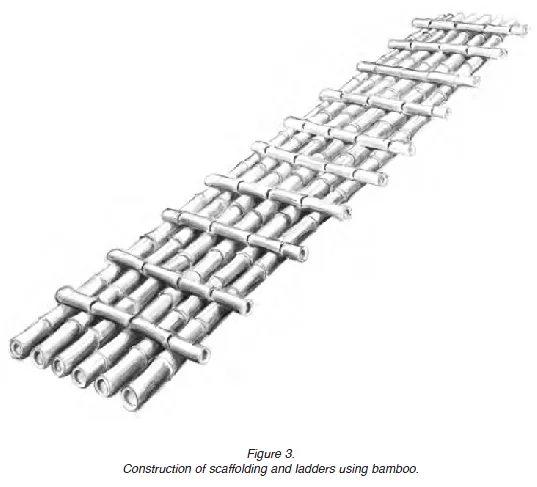
Construction
Thanks to its physical characteristics, bamboo is widely employed for all types of structural elements, from girders and columns to scaffolds and ladders (Figure 3), porches, floors, and arch ribs. It is also used as a structural reinforcement in concrete.
It is employed in walls (Figure 4) as a building or decorative element (mesh).
Bamboo in transverse walls provides rigidity as well as the necessary flexibility to prevent its breaking when it is bent; this special feature makes it appropriate for antiseismic construction.
It can be further employed as floor paving, especially in the form of roofing tiles. Bamboo is ideal for temporary structures since it is light and easily transported and stored.

Food
Bamboo shoots of less than 50 cm in height [about 20 inches] are edible and are highly prized for their high content of iron, calcium, minerals and vitamins.
Phyllostachys pubescens is a sweet bamboo and therefore, the only one that can be eaten without prior preparation.
In Asia the shoots of P. Pubescens are processed and canned, an activity that constitutes an important aspect of the food industry.
Actually, the shoots of all genera and species of bamboo are edible. However they should be peeled and boiled in three changes of water to eliminate the cyanide in them, thus making them safe for consumption and avoiding poisoning.
The bamboo seeds also contain high protein levels, which are highest during flowering.
Architecture
Bamboo’s flexibility was employed profitably by the Vedas in India for providing arches and vaults in their houses; later on, the Bengaleses developed cupolas of bamboo, which even today are typical of the Indian architecture.
Engineering
The construction of hanging bridges of bamboo, with a clearance of some 100 m [over 300 feet] are an example of the physical properties of this material. Bamboo is used in this case instead of cables.
The Himalaya’s Bridge is a good example of this.
Craft works
Different types of furniture, such as chairs, tables, beds, mirrors, lamps, mobiles, folding screens, baskets, vessels and so on (Figures 5, 6 and 7) can be made of bamboo.
Also, and thanks to its tubular form and the strength of its fibers, it is useful in the making of spoons, forks, knives and many other types of small utensils.

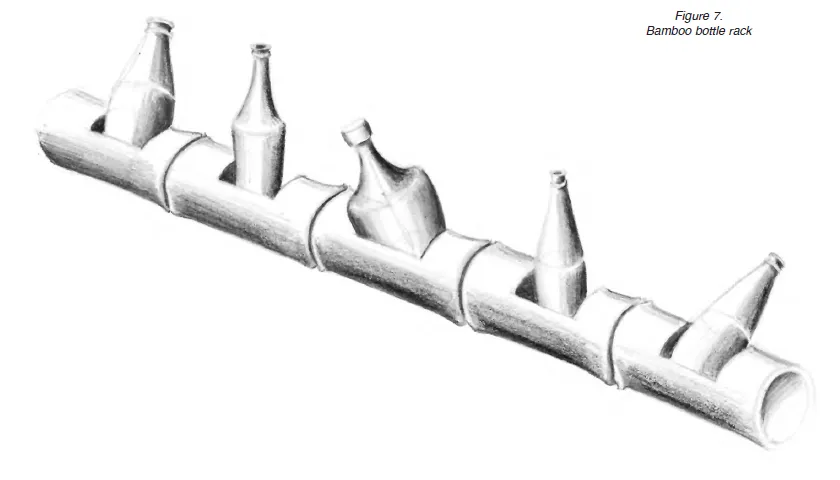
Music
Flutes and saxophone mouthpieces are made of bamboo. Also, as can be seen in Figure 8, stringed musical instruments can also be made of bamboo.

Medicine
The millenarian Oriental medicine has employed bamboo in different ways, among others, in the treatment of ophthalmic illnesses and as anticarcinogenous and antipyretic applications.
In home remedies, the leaves are cooked to combat colds, and the bark is made into a tea to eliminate parasites. Certain enzymes and silica found in the knots are powdered also. In Java and in Borneo, it has been found that bamboo contains a poison that produces a slow and extremely painful death. (O. Hidalgo. Nuestro bambu “la guadua”, 1983.)
Bamboo also produces combustion substances such as alcohol, and lubricating oils.
Paper Making
There is data of early books made of bamboo slats.
Written over 2000 years ago, they record the history of the Chinese monarchy.
Bamboo as well as silk fabrics were later replaced by a lighter and cheaper material. The invention of paper goes back to the year 105 CE in China.
From the time hence, practically all paper production was based on rather traditional methods and employed wood.
Much later, in 1925, bamboo was again put forward as raw material for commercial paper production.
In this case, it was India which took the lead, which it maintains, in the production of bamboo pulp for paper. In Latin America, Brazil is noted for its continuing work in this field.
It is thought that this country will occupy one of the first places in the
production of paper, thanks to the strong encouragement of the cultivation of bamboo.
Bamboo has not only been compared to wood, it could overtake that material if one takes into account a series of influential factors that produce an economic effect. According to known figures, up to 1 ton of dried pulp can be obtained from 2,5 tons of green bamboo. And this is not taking into account the problem of ecological impact which becomes more worrisome every day. In contrast to wood, bamboo does not require 15 to 30 years for it to be useable.
In the case of a new plant, this reaches maturity in a maximum term of six years.
Stalks are cut according to the species, but, the cut stalks produce new shoots within a short time, which in the end, help new growth, thus ensuring continued production without need of reforestation.
There are also certain types of thin paper such as facial tissues for which bamboo fiber is more appropriate.
Bamboo pulp can also be mixed with pulp from other species depending on the kind of paper or cardboard desired.
Studies have been done on the length of bamboo fibre of many species, and it has been determined that a long thin fibre is the most appropriate for the manufacture of paper.
Many different species are recommended for use in paper manufacture, though there are certain better known species traditionally, such as the Arundinaria alpina, used in Kenya; Bambusa tulda in India, and Guadua angustifolia in the A...
Table of contents
- Portada
- Portadilla
- Créditos
- Foreword
- Part 1
- Part 2